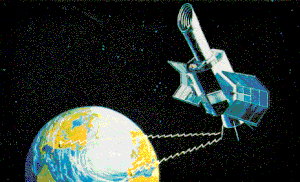
Back ساتل كاشف الأشعة فوق البنفسجية الدولي Arabic International Ultraviolet Explorer Catalan International Ultraviolet Explorer German International Ultraviolet Explorer Spanish کاوشگر فرابنفش بینالمللی Persian IUE Finnish International Ultraviolet Explorer French International Ultraviolet Explorer Galician IUE HE International Ultraviolet Explorer ID
 International Ultraviolet Explorer (Explorer 57) satellite | |
| Names | Explorer 57 IUE SAS-D |
|---|---|
| Mission type | Ultraviolet astronomy |
| Operator | NASA / ESA / SERC |
| COSPAR ID | 1978-012A |
| SATCAT no. | 10637 |
| Website | ESA Science and Technology NASA IUE Archive |
| Mission duration | 18 years, 8 months, 4 days[1] |
| Spacecraft properties | |
| Spacecraft | Explorer LVII |
| Spacecraft type | International Ultraviolet Explorer |
| Bus | SAS (Small Astronomy Satellite) |
| Manufacturer | Goddard Space Flight Center |
| Launch mass | 669 kg (1,475 lb) |
| Power | 424 watts |
| Start of mission | |
| Launch date | 26 January 1978, 17:36:00 UTC |
| Rocket | Thor-Delta 2914 (Thor 628 / Delta 138) |
| Launch site | Kennedy Space Center, LC-17A |
| Contractor | Douglas Aircraft Company |
| Entered service | 3 April 1978 |
| End of mission | |
| Deactivated | 30 September 1996 |
| Last contact | 30 September 1996, at 18:44 UTC |
| Orbital parameters | |
| Reference system | Geocentric orbit |
| Regime | Geosynchronous orbit |
| Longitude | 70.0° West |
| Main telescope | |
| Type | Ritchey-Chretien Cassegrain reflector |
| Diameter | 45 cm (18 in) |
| Focal ratio | f/15 |
| Wavelengths | Ultraviolet 115 to 320 nm |
| Instruments | |
| Particle Flux Monitor (Spacecraft) Ultraviolet Spectrograph Package | |
 ESA patch for the IUE mission Explorer Program | |
International Ultraviolet Explorer (IUE or Explorer 57, formerly SAS-D),[2] was the first space observatory primarily designed to take ultraviolet (UV) electromagnetic spectrum. The satellite was a collaborative project between NASA, the United Kingdom's Science and Engineering Research Council (SERC, formerly UKSRC) and the European Space Agency (ESA), formerly European Space Research Organisation (ESRO). The mission was first proposed in early 1964, by a group of scientists in the United Kingdom, and was launched on 26 January 1978 aboard a NASA Thor-Delta 2914 launch vehicle. The mission lifetime was initially set for 3 years, but in the end it lasted 18 years, with the satellite being shut down in 1996. The switch-off occurred for financial reasons, while the telescope was still functioning at near original efficiency.
It was the first space observatory to be operated in real time by astronomers who visited the groundstations in the United States and Spain. Astronomers made over 104,000 observations using the IUE, of objects ranging from Solar System bodies to distant quasars. Among the significant scientific results from IUE data were the first large scale studies of stellar winds, accurate measurements of the way interstellar dust absorbs light, and measurements of the supernova SN 1987A which showed that it defied stellar evolution theories as they then stood. When the mission ended, it was considered the most successful astronomical satellite ever.[3]
- ^ "International Ultraviolet Explorer - NASA IUE Archive". Barbara A. Mikulski Archive for Space Telescopes. Retrieved 25 September 2023.
- ^ "Display: IUE (Explorer 57) 1978-012A". NASA. 28 October 2021. Retrieved 22 November 2021.
 This article incorporates text from this source, which is in the public domain.
This article incorporates text from this source, which is in the public domain.
- ^ ESA Science & Technology: Summary Archived 2012-09-21 at the Wayback Machine Sci.esa.int Retrieved on 2011-08-27
© MMXXIII Rich X Search. We shall prevail. All rights reserved. Rich X Search